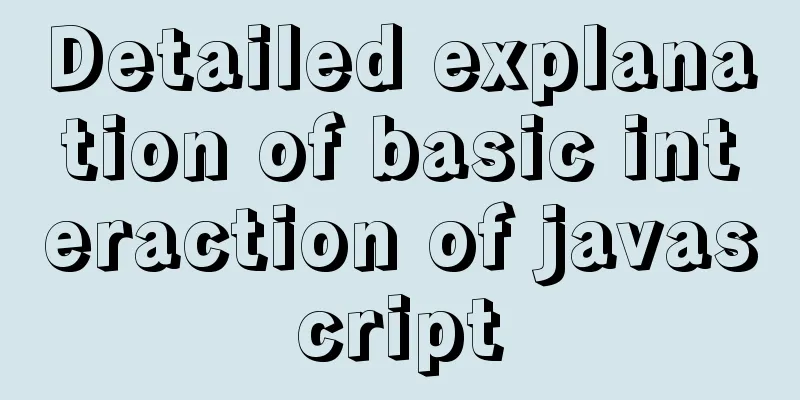Detailed explanation of basic interaction of javascript

1. How to obtain elementsGet it from the documentAs long as it is in the document, it will be obtained ID acquisition
var box = document.getElementById("box1");
console.log(box);//<div id="box1">I am DIV</div>
var box = document.getElementById("box2");
console.log(box); //null
var myH2 = document.getElementById("my-h2");
console.log(myH2);Get the class name (className)
var tests = document.getElementsByClassName("test");
console.log(tests);
console.log(tests.length); //Get the length // Output directly to the console console.log(tests[0]);
console.log(tests[1]);
console.log(tests[tests.length - 1]);
// Store it var oDiv = tests[0];
var oH2 = tests[1];
console.log(oDiv, oH2);
var test1 = document.getElementsByClassName("test1");
console.log(test1, test1.length);
console.log(test1[0]);
console.log(test1[1]); //The absence of this subtitle or index is equivalent to the position in the collection not being initialized, or undefined returns undefined
var hello = document.getElementsByClassName("hello");
console.log(hello, hello.length);
console.log(hello[0]); //undefinedTag Name (tagName)
var oLis = document.getElementsByTagName("li");
console.log(oLis);
// Get the length console.log(oLis.length);
// Get the specific element console.log(oLis[0]);
console.log(oLis[1]);
console.log(oLis[2]);
console.log(oLis[oLis.length - 1]);Customize the acquisition scopeParent element: must be a specific element
// Get the li under ol
// Get the parent element var wrap = document.getElementById("wrap");
console.log(wrap);
// var oLis = wrap.getElementsByClassName("test");
var oLis = wrap.getElementsByTagName("li");
console.log(oLis);
console.log(oLis.length);
console.log(oLis[0]);
console.log(oLis[1]);
console.log(oLis[oLis.length - 1]);
// Get the li under ul
// Get the parent var wrap1 = document.getElementsByClassName("wrap");
console.log(wrap1);
console.log(wrap1[0]);
console.log(wrap1[1]);
// var ullis = wrap1[1].getElementsByClassName("test");
var ullis = wrap1[1].getElementsByTagName("li");
console.log(ullis);
console.log(ullis.length);
console.log(ullis[0]);
console.log(ullis[1]);
console.log(ullis[ullis.length - 1]);2. Mouse eventsThe binding event must also be a specific element, and the collection cannot be operated directly
<div id="box"></div>
<ul id="myUl">
<li>1</li>
<li>2</li>
<li>3</li>
</ul>
<script>
var box = document.getElementById("box");
console.log(box);
var myUl = document.getElementById("myUl")
console.log(myUl);
var oLis = myUl.getElementsByTagName("li");
console.log(oLis);
// - onclick click event box.onclick = function() {
console.log("click");
}
// - ondblclick double-click event oLis[0].ondblclick = function() {
console.log("double click event");
}
// - onmousedown The mouse is pressed oLis[1].onmousedown = function() {
console.log("mouse pressed");
}
// - onmouseup The mouse is raised oLis[1].onmouseup = function() {
console.log("Mouse up");
}
// - onmousemove mouse moves oLis[1].onmousemove= function() {
console.log("mouse move");
}
// - oncontextmenu right click oLis[2].oncontextmenu = function() {
console.log("right click");
}
// - onmouseover The mouse moves into myUl.onmouseover = function() {
console.log("Mouse moves in");
}
// - onmouseout The mouse moves out myUl.onmouseout = function() {
console.log("mouse out");
}
// - onmouseenter The mouse enters myUl.onmouseenter = function() {
console.log("mouse enter");
}
// - onmouseleave The mouse leaves myUl.onmouseleave = function() {
console.log("mouse leaves");
}
</script>
the difference:onmouseover and onmouseout will not only trigger the corresponding events of their own events, but also trigger the corresponding events of the parent events again. onmouseenter and onmouseleave: only trigger the corresponding actions of their own events, and will not trigger the corresponding actions of the parent event 3. Element OperationPrinciple: Giving a value is setting, not giving a value is getting All operations on elements must be specific elements, and collections cannot be operated directly 1. Operation element contentThe content obtained from the element is a string, and an empty string is obtained if there is no content. Manipulating form element content
// Multiple assignments overwrite the previous ones
// Get elements var inputs = document.getElementsByTagName("input");
var btn = document.getElementsByTagName("button")[0];
console.log(inputs, btn);
// Display the sum of the two input boxes in the third input box // Bind event // The code in the function will be re-executed every time the event is clicked btn.onclick = function () { // What to do // Get the values of the two input boxes var oneVal = inputs[0].value;
var twoVal = inputs[1].value;
console.log(oneVal, twoVal);
// When encountering a string, convert it to a number first var total = parseFloat(oneVal) + parseFloat(twoVal);
console.log(total);
// Set the sum to the third input box inputs[2].value = total;
}Operate normal closing tag
var div = document.getElementsByTagName("div")[0];
var h2 = document.getElementsByTagName("h2")[0];
var p = document.getElementsByTagName("p")[0];
console.log(div, h2,p);
// Setting: form element.innerText/innHTML = value;
// The latter settings cover the former // div.innerText = "I am div";
// div.innerText = "<h6>I am div</h6>";
// div.innerHTML = "I am div";
div.innerHTML = "<h6><a href='https://www.baidu.com'>I am div</a></h6>";
h2.innerHTML = "I am H2";
// Get: form element.innerText/innHTML;
console.log(div.innerText);//I am div
console.log(div.innerHTML);//<h6><a href="https://www.baidu.com">I am div</a></h6>
console.log(p.innerText);
console.log(p.innerHTML);2. Operation element attributesInnate properties of the operating structure
// Get the element var div = document.getElementsByTagName("div")[0];
// Set div.className = "myBox";
div.title = "I am div";
// Get console.log(div.id);
console.log(div.className);
console.log(div.title);SummarizeThis article ends here. I hope it can be helpful to you. I also hope that you can pay more attention to more content on 123WORDPRESS.COM! You may also be interested in:
|
<<: Solution to the problem that Docker container cannot access Jupyter
>>: A thorough analysis of HTML special characters
Recommend
Pygame code to make a snake game
Table of contents Pygame functions used Creating ...
Tips for turning pixels into comprehensive brand experiences
Editor: This article discusses the role that inte...
A simple example of using Vue3 routing VueRouter4
routing vue-router4 keeps most of the API unchang...
Detailed explanation of MySQL database Event scheduled execution tasks
1. Background As the project's business conti...
How to open port 8080 on Alibaba Cloud ECS server
For security reasons, Alibaba Cloud Server ECS co...
Detailed explanation of the definition and function of delimiter in MySQL
When you first learn MySQL, you may not understan...
How to get the dynamic number of remaining words in textarea
I encountered a case at work that I had never wri...
Detailed example of getting the maximum value of each group after grouping in MySQL
Detailed example of getting the maximum value of ...
Will mysql's in invalidate the index?
Will mysql's IN invalidate the index? Won'...
HTML scroll bar textarea attribute setting
1. Overflow content overflow settings (set whether...
Docker deployment of Flask application implementation steps
1. Purpose Write a Flask application locally, pac...
Example code for implementing dynamic skinning with vue+element
Sometimes the theme of a project cannot satisfy e...
MySQL 8.0.11 installation and configuration method graphic tutorial (win10)
This article records the installation and configu...
How to upload projects to Code Cloud in Linux system
Create a new project test1 on Code Cloud Enter th...
Detailed explanation of the cache implementation principle of Vue computed
Table of contents Initialize computed Dependency ...









